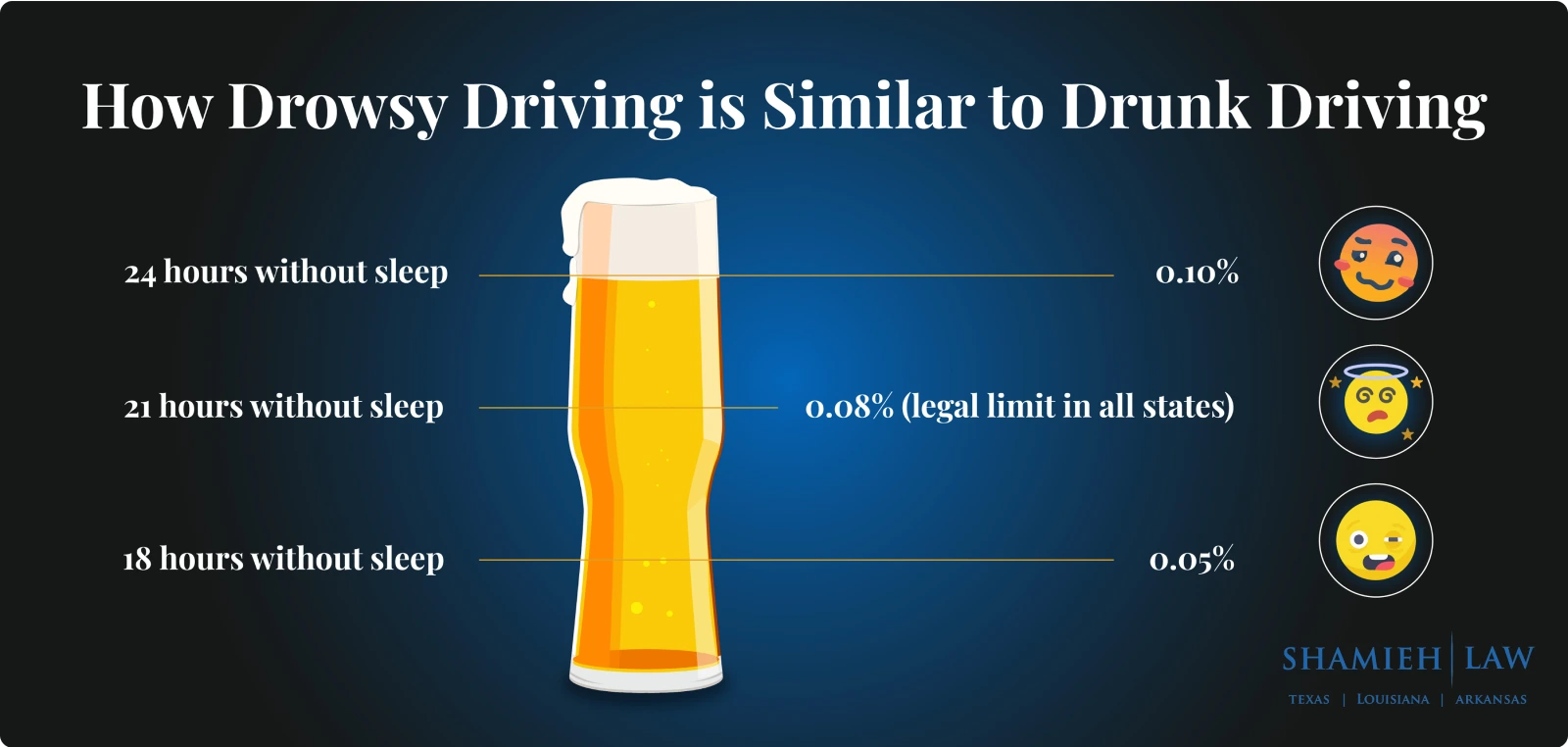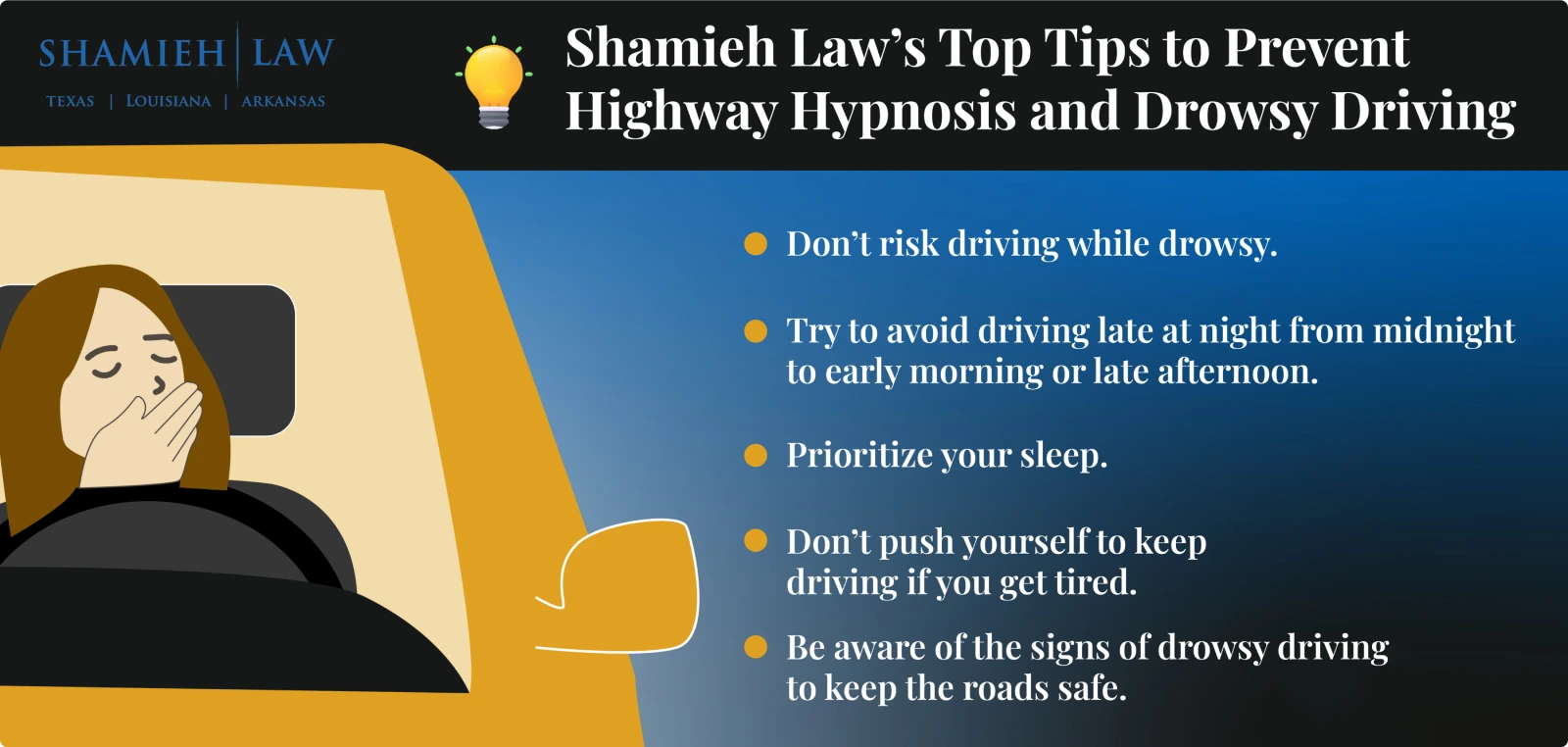The Dangers of Driving
While Tired—Highway Hypnosis
Driving while tired may seem harmless, but it can lead to serious, even life-threatening, consequences. If you’ve been behind the wheel for hours, you could experience a microsleep, where you briefly doze off without realizing it. Just three seconds of lost focus could lead to a devastating crash.
Drowsy driving has been shown to impair your ability to drive, similarly to drunk driving. Driving while tired poses serious dangers, even if you have done it before.
What Is Highway Hypnosis?
f you’ve been driving and suddenly reached your destination without remembering the drive, you might have experienced highway hypnosis. This occurs when you lose track of time or experience disconnection while driving, particularly on familiar roads or long, empty highways.
Highway hypnosis is a trance-like state, making you less alert and more vulnerable to the dangers of driving while tired. Signs of highway hypnosis include:
- Loss of concentration
- Heavy eyes or frequent blinking
- Yawning often
- Wandering thoughts or a dazed feeling
- Difficulty maintaining your lane
- Inability to remember the last few minutes of driving
You might not realize you’re in this state until you’ve snapped out of it. Being in this state can mean you’re less aware of your surroundings and less reactive to the road.
Getting a little more sleep each night can make all the difference in your driving ability. People sleeping 6 to 7 hours a night are twice as likely to be involved in a sleep-related accident as those who sleep 8 hours or more.
What are the Dangers of Driving While Tired?
Driving tired puts you and other drivers at risk, including:
- Reduced awareness: You might have difficulty concentrating and delayed reactions to hazards in the roadway.
- Impaired judgment: More difficult to make decisions, like braking or determining the distance of other vehicles.
- Reduced control: Drowsiness can cause swerving, delayed braking, and difficulty staying in your lane.
- Falling asleep at the wheel: Even briefly falling asleep while driving can cause disastrous consequences for you and others, such as drifting into another lane, rear-end collisions, or running stop signs.
To prevent drowsy driving, it’s recommended to prioritize getting at least seven hours of sleep the night before a long drive and take frequent breaks. Traveling during the day can help, and taking a 30-minute nap can improve your attention.
According to the AAA Foundation for Traffic Safety, if you’ve slept less than two hours a day, you should not drive. If you’ve slept less than 4 or 5 hours a day, you could be considered impaired. Studies show that being awake for over 24 hours is similar to having a blood content of .10%, above the legal limit.
If you’ve stayed awake over four hours and plan to drive, know that you could have the same ability as someone driving drunk.

Who Is Most at Risk of Highway Hypnosis?
Highway hypnosis can happen to those driving long hours, including:
- Long-haul truckers and commercial drivers
- Drivers on road trips or long commutes
- Night shift workers
- Delivery or rideshare drivers
- Drivers with irregular sleep schedules
- Younger and teen drivers
- Drivers with sleep disorders
If you take medication, always check the label for drowsiness warnings before getting behind the wheel. Some medications, like allergy medicines or other prescriptions, can cause sleepiness.
The most important thing you can do for yourself and other drivers is to get enough sleep at night. The National Sleep Foundation found that adults are more likely to find an alternative to driving after a few drinks than when they haven’t had enough sleep.
How to Recognize the Signs of Drowsy Driving and Highway Hypnosis
There are more ways to tell if you’re beginning to feel highway hypnosis or tired driving. Some of these signs can be subtle or easy to ignore, including:
- Day dreaming
- Missing traffic signs
- Missing a turn or exit
- Drifting between lanes
- Slow reaction to traffic
- Following the car ahead too closely
- Your head nodding or your eyes starting to close
Experiencing these signs while driving might seem minor, but even a moment of lost consciousness can cause serious consequences.
Tips to Prevent Highway Hypnosis and Drowsy Driving
Don’t risk driving while drowsy. Take breaks every couple of hours on the road, and get seven to nine hours of sleep before a long day of driving. If possible, share driving duties and don’t go alone.
Try to avoid driving late at night from midnight to early morning or late afternoon. Coffee and caffeine alone aren’t enough to keep you awake, and you shouldn’t rely on music or windows down with air conditioning on to stay focused.
If you work a night shift or strange hours, prioritize your sleep. Try short power naps if you’re tired during the day, but aim for seven to nine hours of sleep a night.
Your driving ability is significantly impaired if you’ve had less than four hours of sleep. There’s no replacement for sleep and good rest. Don’t push yourself to keep driving if you get tired.
Be aware of the signs of drowsy driving to keep the roads safe, and consider getting a ride if you’re too tired to drive.

Legal Consequences of Drowsy Driving Accidents
Driving while fatigued can have serious legal repercussions. In Texas, fault in an accident is determined under the modified comparative fault rule, meaning you can only recover damages if you are less than 51% at fault. If you’re found more than 50% responsible, you are barred from recovering compensation.
Drowsy driving can increase your liability in a crash. In personal injury claims, your level of alertness—or lack thereof—can impact fault allocation and your ability to recover damages.
In commercial vehicle cases, federal Hours-of-Service regulations are often central to proving negligence. These rules require drivers to:
- Take a 30-minute break after eight cumulative hours of driving, and
- Drive no more than 11 hours in a 14-hour window, following at least 10 consecutive hours off duty.
If a driver or their employer violated these laws—for example, by failing to log required breaks—they may be held liable for resulting accidents. Driver logs, company time records, and other documentation can help prove noncompliance.
What to Do If a Drowsy Driver Injures You
After any car accident, be sure to:
- Move yourself and your vehicle to a safe location, then call 911. Even if the accident is minor, call the police to report the accident.
- Take the other driver’s insurance and contact information. Contact your insurance, too.
- Take pictures of the accident scene, vehicles, and any injuries.
- Go to the hospital and get checked out. Some injuries might not be immediately apparent, and it’s best to ensure you’re okay after an accident.
This ensures your rights are protected from the start and strengthens your ability to prove the other driver was impaired by fatigue. The most important step is contacting an experienced car accident lawyer. By connecting with a lawyer from Shamieh Law, our attorneys can help you determine exactly what happened and pursue compensation.
If a drowsy driver injures you, there are steps you can take to help prove their fatigue, including:
- Receiving commercial driver logs
- Obtaining the driver’s shift records
- Getting witness testimony
- Noting the other driver’s tiredness at the scene
How a Car Accident Lawyer Can Help
Drowsy driving is far more serious than you might think. Get plenty of rest before long drives to keep you and your loved ones safe.
Whether you were injured in a car accident in Dallas, Austin, or elsewhere in Texas, Shamieh Law can help you pursue compensation, including past and future medical bills, lost wages, pain and suffering, and reduced quality of life. After your free consultation, we’ll start working on your case immediately to get answers and results quickly. We work on a contingency fee basis—so you pay nothing unless we win your case.
Contact us today or call (866) 552-1801 if you believe drowsy driving affected your accident. We’re ready to fight for the justice and recovery you deserve, with dedicated legal support every step of the way.